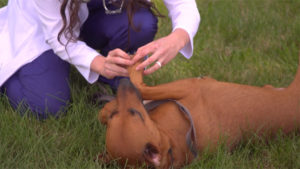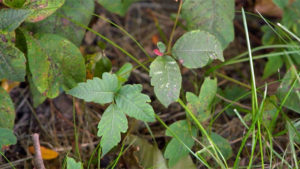rving with pets
Pets and Poison Ivy with Dr. Fitz on 'Paws on Board'
Welcome to “Rollin’ on TV’s” “Paws on Board.” I’m Dr. Fitz, and this is Scooby. Have you ever been exposed to poison ivy? For some people, it can cause debilitating blisters and sores, enough to make you want to avoid anything green for quite a while. Did you know that dogs can also suffer from the effects of the plant?
 Due to their fur, most dogs have no side effects after coming into contact with poison ivy; however, dogs
Due to their fur, most dogs have no side effects after coming into contact with poison ivy; however, dogs
with allergic skin conditions, short fur, or just short dogs in general, have a higher risk of exposure and a reaction.
Dogs and humans both react to the oils of the plant. Dogs may develop a mild skin rash or even progress to open blisters. Your pet may also be extremely itchy. If your pet has a mild reaction to the plant, keeping the area clean with a gentle soap and water can be helpful. If that rash does not go away or if it progresses to blisters, your pet should be seen by a veterinarian. They may need steroids to reduce itch and irritation and even antibiotics if there’s a skin infection. Places you may wanna check your pet for reaction are their feet. Make sure to check between their toes and paw pads. Their belly and groin areas if the plant came into contact from below. And even their neck and chin; while they’re sniffing the ground, they could’ve also come into contact with the plant that way. If your pet does not react, this does not mean that the danger is over. Pets can actually carry oil from the plant in their fur and expose you to the oils when you snuggle them that evening. A great way to avoid this is to keep your dog leashed at campgrounds and on trails. This way, your dog is always nearby, and you can prevent them from coming into contact with unknown plants. If you’re unsure if your pet has contacted poison ivy, the best thing to do is to bathe your pet. Use lukewarm, soapy water to remove the oils from their fur. You may wanna wash their collar or leash as well.
 Identifying poison ivy can be somewhat difficult. I grew up with the saying, “Leaves of three, let it be,” but primarily look for thin stems with clusters of three leaves. Poison ivy can climb and be ivy-like or even appear as a small bush or shrub. When in doubt, avoid the plant and wash anything that may have contacted it.
Identifying poison ivy can be somewhat difficult. I grew up with the saying, “Leaves of three, let it be,” but primarily look for thin stems with clusters of three leaves. Poison ivy can climb and be ivy-like or even appear as a small bush or shrub. When in doubt, avoid the plant and wash anything that may have contacted it.
For more information about traveling safely with your pets, visit rollinontv.com. Tune in next time for more pet health information. I ‘m Dr. Fitz, and this is Scobby. Thanks for watching “Paws on Board”.


